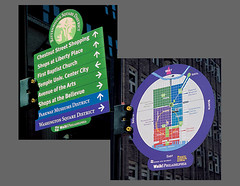Asking for directions and getting the right answer
Flickr image from RethinkCollegePark, who writes: The largest pedestrian wayfinding system in North America, Walk!Philadelphia encompasses over 2,200 sign and map faces. It consists of directional signs and heads-up diskmaps (with the direction the user is facing at the top of the map). The brackets were designed specifically for this program to fit multiple pole profiles.
One of the reasons that I like wayfinding systems is that they aren't specific to the person you're asking directions from.
I was staying at East Ohio Street and State Street. I couldn't remember exactly where the Washington Library is (it's at State and Van Buren Streets). I asked how to get there without looking it up. I would have walked. But if you ask hotel clerks who aren't accustomed to walking places how to get somewhere you get cockeyed directions.
Similarly, the day before I was on Dearborn Street, walking towards Lake Street, and I asked someone, just to confirm what I was doing, about directions to the blue line station. He tried to give me cockeyed directions (go over to Chicago Street, etc.) and I knew they weren't right. He then exclaimed "well, you're the one who asked for directions."
Similarly in DC, I've stepped in to give directions when I've overheard bad directions, e.g., at 17th and L Street NW two women asked for directions to Massachusetts Ave. NW to get to the Peruvian Embassy (at Mass and 17th Streets NW). The person, a BID employee, seemed to only be familiar with Massachusetts Ave. SE, and was about to direct them there...
I've since learned to ask people specific questions about where they are trying to go ("Vermont? The city or the street?") to give them the right directions. Because you have to answer the question from their perspective and need, not yours.
And we need to put more energy into training hotel personnel to be comfortable and familiar with giving directions for modes other than cars--for bus, subway, walking, and bicycling. A number of cities have orientation programs for people working in the tourism field. I don't think DC does and it should.
-----------
-- Detroit Orientation Institute - Welcome
The Detroit Orientation Institute (DOI) is a program at Wayne State University that provides a historical perspective and candid look at the region.
- Detroit Orientation Institute - 3-Day programs
- Heritage Tourism Training > Banff Heritage Tourism Corporation ...
Part of Banff Heritage Tourism Corporation's mandate is to strengthen employee orientation, training and programming as it relates to sharing heritage.
Labels: cultural heritage/tourism, tourism, wayfinding




0 Comments:
Post a Comment
<< Home